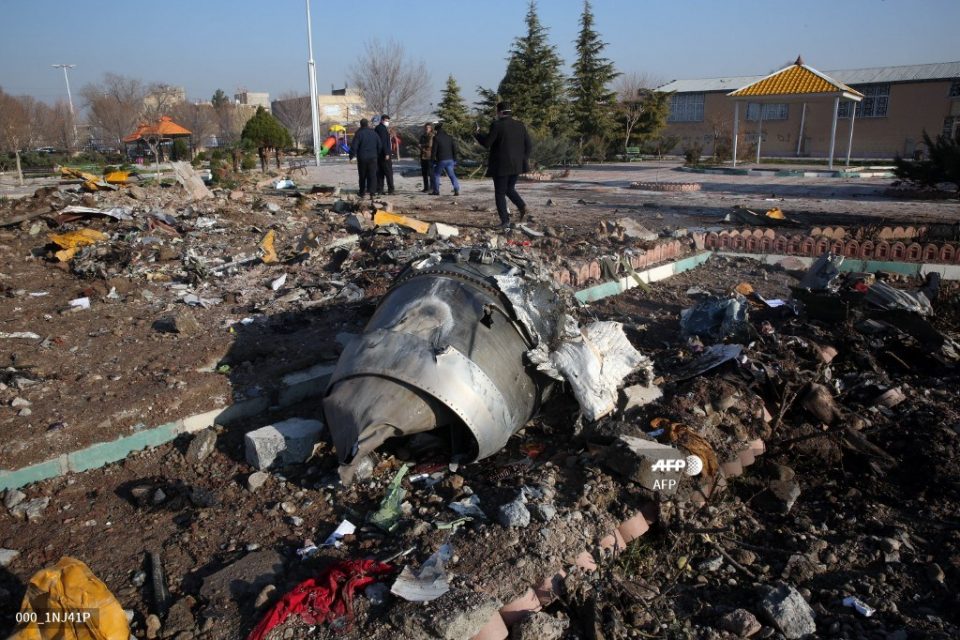
By Amir Havasi
TEHRAN, IRAN (AFP) — Iran’s civil aviation chief denied Friday that a missile downed a Ukrainian airliner which crashed killing all 176 on board, dismissing claims of a catastrophic mistake by Tehran’s air defences.
The declaration came as Tehran faced mounting international pressure to allow a “credible” investigation into the crash, which several Western governments blamed on an accidental missile strike.
“One thing is for certain, this airplane was not hit by a missile,” Iran’s civil aviation chief Ali Abedzadeh said, after Tehran invited the US, Canada and others to join the investigation.
The Boeing 737 crashed on Wednesday shortly after Iran launched missiles at US forces in Iraq in response to the killing of a top Iranian general in a US drone strike in Baghdad.
It is Iran’s worst civil aviation disaster since 1988 when the US military said it shot down an Iran Air plane over the Gulf by mistake, killing all 290 people on board.
The majority of the passengers on Ukraine International Airlines Flight PS752 were dual national Iranian-Canadians but they also included Ukrainians, Afghans, Britons and Swedes.
Canadian Prime Minister Justin Trudeau said Thursday that multiple intelligence sources indicated that an Iranian surface-to-air missile downed the plane after it took off from Tehran.
“We know this may have been unintentional. Canadians have questions, and they deserve answers,” Trudeau told reporters.
But Abedzadeh rejected the allegation, saying that “any remarks made before the data is extracted (from the plane’s black box flight recorders) … is not an expert opinion.”
Trudeau’s comments came as video footage emerged that appeared to show the moment the airliner was hit.
The footage, which The New York Times said it had verified, shows a fast-moving object rising at an angle into the sky before a bright flash is seen, which dims and then continues moving forward. Several seconds later an explosion is heard.
– ‘Important data’ –
Ukrainian Foreign Minister Vadym Prystaiko said US officials have handed Kiev “important data” following the crash.
Tehran’s foreign ministry said that a Canadian delegation was en route to Iran to “handle the affairs of the Canadian victims”, a rarity since the two countries cut diplomatic relations in 2012.
Iran’s civil aviation chief said Tehran had invited “Americans, Canadians, the French, Ukrainians and the Swedish” to be present during the investigations, showing that “we are honest in our procedure”.
The US National Transportation Safety Board said late Thursday it had received formal notification of the crash from Iran and would send a representative to join the investigation.
Iran’s foreign ministry earlier invited US plane maker Boeing to “participate” in the probe.
Canada’s transportation safety board said it had also accepted an invitation to join the inquiry.
France is the co-manufacturer of the plane’s engines, and has offered its expertise because it is one of the few countries able to comprehensively decipher black box data.
Trudeau was backed by other Western leaders, including British Prime Minister Boris Johnson who said mounting evidence supported a missile strike, which “may well have been unintentional”.
US President Donald Trump indicated that Washington officials believed the Kiev-bound Boeing 737 was struck by an Iranian missile.
“I have my suspicions,” Trump said, adding that “somebody could have made a mistake.”
Unidentified officials told US media that satellite, radar and electronic data indicated Tehran’s air defence units downed the aircraft.
The Netherlands said that its military intelligence also had information indicating that an “Iranian anti-aircraft missile” probably brought down the plane.
The European Union demanded an “independent and credible” probe into the crash.
– Radio silence –
But Iran’s aviation authority chief said the missile theory could not be “scientifically correct” because it was not possible for an airliner to be hit and “continue flying for 60 to 70 seconds”.
And “the debris collected has been in a very limited area. If there was an explosion in the wings it should have been much more scattered,” Abedzadeh added, noting that analysing the black box data “will take time”.
The airliner went down in the dark just minutes after takeoff, with no radio message from the pilot to indicate distress, according to the Iranian aviation authorities.
The pilot did not call the tower because “he must have been trying to save the airplane before anything else,” Abedzadeh said.
German carrier Lufthansa said it was cancelling all flights to and from Tehran until January 20 “due to the unclear security situation for the airspace around Tehran airport”.
Sweden said it was stopping Iran Air flights between the two countries because of safety concerns.
Several other airlines had already announced they would avoid Iranian and Iraqi airspace as tensions in the region soared.
Ukraine called for United Nations support for a broad investigation, and sent 45 crash investigators to Tehran to take part in the inquiry led by Iranian authorities.
Investigators are pursuing several possibilities, including engine failure, a missile strike or an act of terror.
As speculation about the cause grew, Hesamodin Ashena, a senior advisor to President Hassan Rouhani, warned Iranians working for Farsi-language media abroad to “not participate in the psychological warfare” against Iran over the plane crash.
© Agence France-Presse
